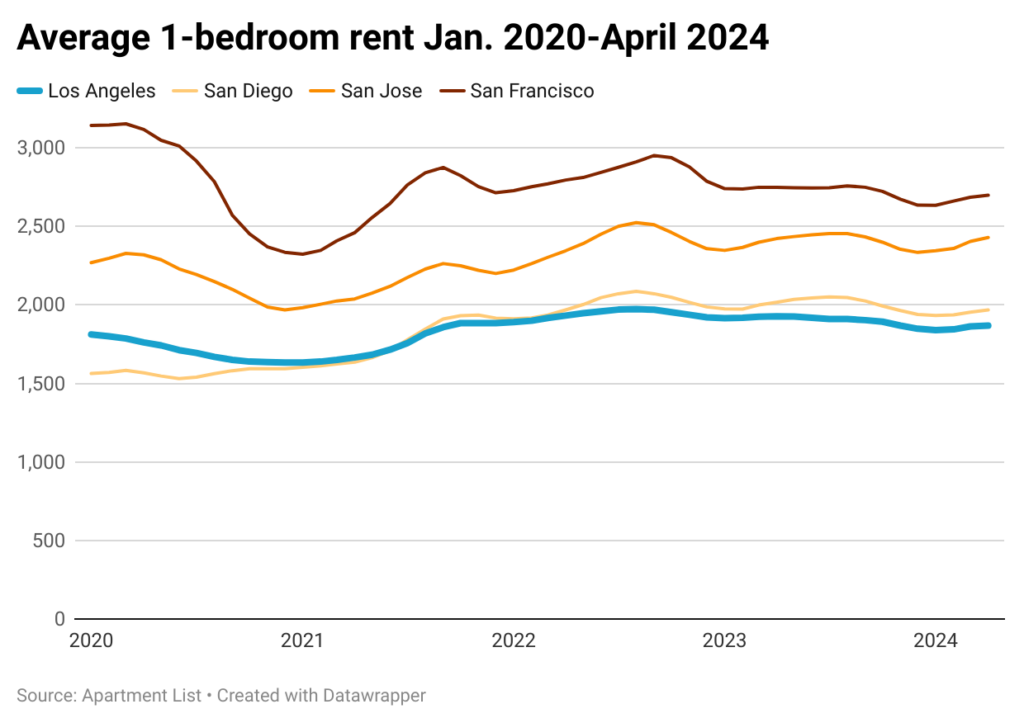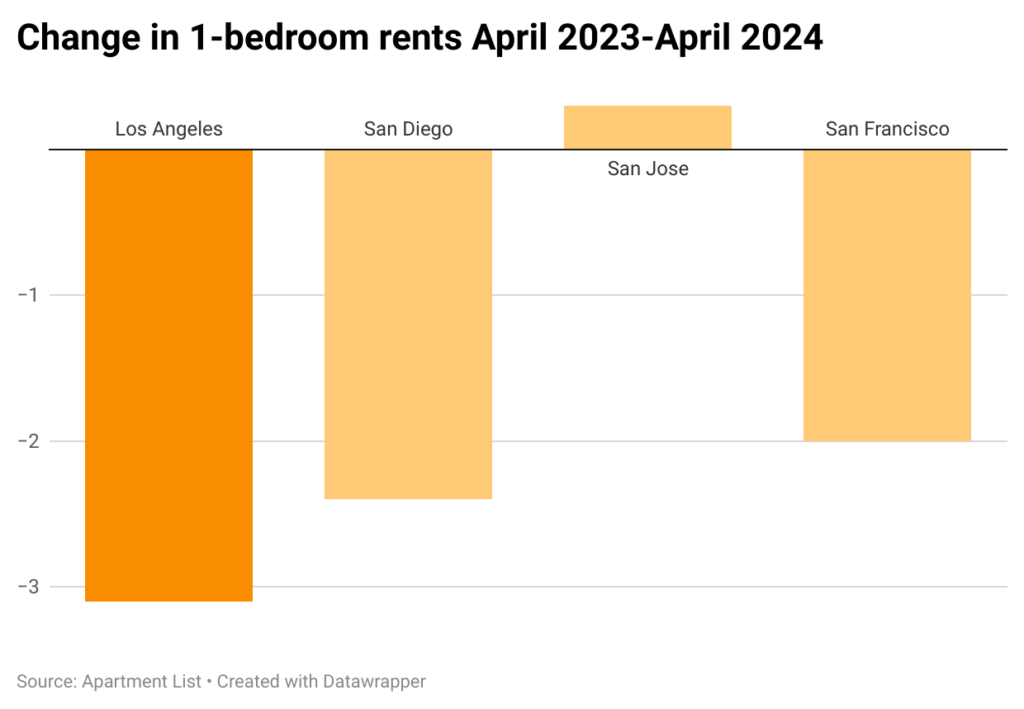Rents are falling across Los Angeles

As Southern California shakes off its pandemic hangover, rents in Los Angeles have edged downward, dropping faster than many other major American cities.
Over the past year, the average rent for a one-bedroom apartment in the city of Los Angeles fell 3%, to $1,868, according to data compiled by real-estate firm Apartment List. That decline is four times greater than the national average, and represents the biggest drop of any major city in California.
Other large metropolitan areas, including New York City, Chicago and Philadelphia, all saw positive rent growth within the past year.
[Get crime, housing and other stats about where you live with the Crosstown Neighborhood Newsletter]
The decrease is the latest turn in the rollercoaster ride that has shuffled real estate in the area since the beginning of the pandemic. At the start of the COVID era, in 2020, many people fled a desolate Downtown and other dense neighborhoods in favor of more space. Then, as restrictions eased, people began to return, reversing a year-long period of falling rents.
But over the past year, a number of factors have conspired to alter that trend once again.
“The pendulum swung again in the other direction. And we’re back now in a period where rent prices are falling,” said Rob Warnock, senior research associate at Apartment List.

One reason, said Warnock, is that construction projects held back early in the pandemic have come online in the past year, providing an influx of housing. At the same time, the crush of people moving back into dense urban areas has run its course.
“More housing options, coupled with fewer people looking to move into those new homes,” said Warnock, “creates this environment where landlords don’t really have a lot of opportunity to raise rents.”
This has forced some property managers to do the unthinkable: lower rents. Daniel Tenenbaum, founder of Pacific Crest Real Estate, a property management firm, has recently reduced prices on numerous properties due to low demand. Part of the reason is the continued prevalence of remote work. Many office workers who still commute often combine that with one or two days of working from home.
“Now, if you don’t even have to come into work, you may just decide to live in a different part of the city,” said Tenenbaum.
Looking to keep it affordable
The decline in rents in Los Angeles outpaces that in some other major California cities. The average rent for a one-bedroom apartment in San Diego declined by 2.5% over the past year, and San Francisco saw a 2% drop despite high office vacancy in its downtown area.

While some suburban areas such as Irvine, Santa Clarita and Anaheim saw positive rent growth, others cities, including Calabasas and Pomona, did not. Their decline was further exceeded by the 8% drop in Santa Monica and West Hollywood.
Alex Raabe, who has lived in Los Angeles for 12 years, is thinking about leaving the city. A decade ago, Raabe found a rent-controlled studio in Koreatown for $750 a month. Now his landlord is looking to sell the property. Raabe has learned that units similar to his currently go for triple the price.
According to Apartment List, the average rent for a Los Angeles studio last month was over $1,800.
Another obstacle for Angelenos is high security deposits. Rent currently eats up more than 70% of Raabe’s monthly income, and finding a new place has been difficult due to the large amount of cash he is required to put up.
“We can’t afford $7,000 to $10,000 just to move into a place because a lot of places want first and last month’s rent, and a security deposit. Then they want a pet deposit too,” said Raabe.
How long the current trend lasts is hard to predict. Jeff Faller, president of the Apartment Owners Association of California, noted that a number of one-time factors during the pandemic put downward pressure on the market. COVID-era eviction protections, he noted, “basically made people stay put. So there wasn’t a lot of movement happening.”
COVID rent protections in the city expired in February, and also let property managers raise rents for the first time since the start of the pandemic; hikes of 4% were allowed (or 6% if the owner pays utilities). However, many owners and building managers complain that they were hit by steep inflation during this period, and that the increase is not enough to cover rising costs.
Faller said he is seeing signs that rents may remain sluggish for some time.
“What we’ve noticed is that there have been fewer tenant screenings,” he said. “So what that leads us to believe is that people are not moving around as much.”
How we did it: We examined monthly average rent data in Los Angeles and beyond from Jan. 1, 2020–April 30, 2024 compiled by Apartment List.
Have questions about our data? Write to us at askus@xtown.la.






